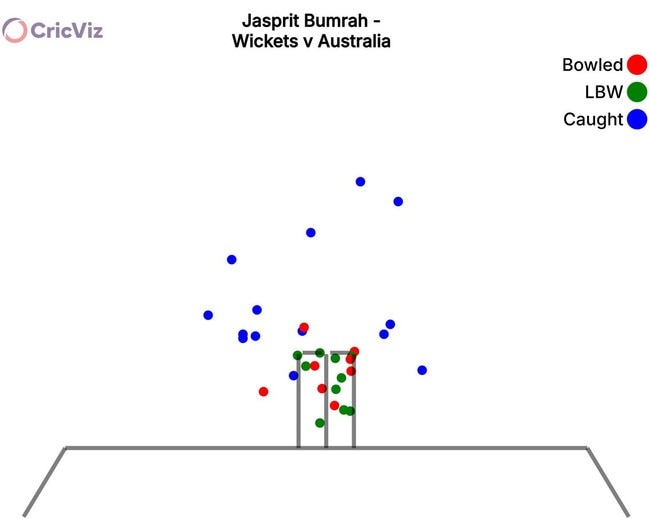What it is like to face India’s great fast bowler Jasprit Bumrah
It’s a bowling action that is as compelling to watch as it is dangerous to face, but what is the key to Indian quick Jasprit Bumrah’s action? We go to the experts to break it down.

Cricket
Don't miss out on the headlines from Cricket. Followed categories will be added to My News.
In the words of former Indian captain Kris Srikkanth, Jasprit Bumrah “is probably one of the greatest bowlers the world has ever seen, one of the modern all-time greats.”
With a Test bowling average under 21 as well as a suite of achievements in white-ball cricket, it is hard to disagree with that assessment.
What is it that makes the Indian pace spearhead so dangerous?
If you were to ask the recently retired David Warner he would suggest the unique action, unlike any other in world cricket.
“The key challenge of Bumrah is getting used to his action. If you haven’t faced him before, it can be quite challenging. You’ve got to try and get used to the stutter at the crease. And then he lets go some thunderbolts,” Warner said.
“He always hits line and length. Can swing them both ways. I think the beauty of him is he’s got two different gears. He can pitch it up when the ball is new and then he can go the other length.”
But there is also a scientific explanation that details why batsmen find him so tough to deal with. Starting with an almost innocuous, 15-step bouncy run-up from which he unleashes pure heat on the opposing batsman.
According to Paul Felton, a senior lecturer in biomechanics at Nottingham Trent University who has consulted with cricket coaches in the UK and Australia, Bumrah has been able to make the most of his clear natural advantage – hypermobility – by also doing the basics very well.
“He gets two advantages from his hypermobility. One is that he can hold onto the ball for far longer giving him more time to generate speed, the second he can get into a position closer to the batter at release which reduces their reaction time,” Felton says.
“The research suggests there’s four key characteristics that the fastest bowlers adopt to generate pace. On average, the fastest bowlers generally have quicker run-ups.
“They tend to keep the front leg straighter as this provides a better conversion of run-up momentum into angular momentum which helps generate ball speed. The trunk flex further forwards, which is a good indication sign of how well they have transferred the run-up momentum.
“And they have greater delay in their bowling arm circumduction. This works similar to a hyperextending elbow, allowing the upper arm to rotate further. A delayed bowling arm allows the trunk to flex further forward so that you can release the ball towards the target.
“This increases the time and range of motion speed can be generated over – if you then add an elbow that can hyperextend, and more than likely greater range of motion in the wrist, it increases the range of motion and time further, and it provides an explanation of how he is able to generate speed uniquely.
“In addition, his hypermobility also provides further advantages (in) that he is able to maintain alignment throughout his bowling action which reduces variability in his control of line and length. So, his hypermobility makes him unique; that he’s able to maximise speed by accessing more optimal movement patterns which increases control and provide lower injury risk.”
Star Australian batter Travis Head says the biggest challenge is coming up against Bumrah for the first time.
“It’s just trying to get, I guess, up to speed, but like just trying to get acclimatised to it as quickly as possible. So it takes some time. The more times you face him, you sort of know what you’re looking for, I guess, release points, etc,” Head says.
Australian captain Pat Cummins likened coming up against Bumrah to batting against former Sri Lankan quick Lasith Malinga, renowned for his slinging action.
“You always imagine that it’s going to come out of the umpire’s stomach, not just tracing a normal eyeline. So that’s a little bit to get used to,” Cummins said.
“It’s fast-paced, but also quite skilful. It’s a little bit of a different angle to what you’re used to so, yes, just a little bit more awkward than someone who’s got a nice run up and nice action.”

According to Felton, Bumrah has an empirically founded advantage because of his unusual attributes.
“We wrote a paper in 2016 which suggested that bowlers that can hyperextend their elbow increase ball speed in two ways,” Felton said.
“Firstly, the elbow recoils back towards the batter close to release similar to a spring recoiling which increases speed. But also because the elbow is more extended you can rotate your upper arm further towards the batter while keeping the lower arm in position to release the ball towards the batter. These two combine, and we highlighted a bowler with around 20 degrees of hyperextension has an increase equivalent to about five per cent in pace compared to somebody that can’t hyperextend. And I would suggest bowlers such as Bumrah or Jofra Archer hyperextend beyond 20 degrees so this is likely to be higher before even consider the reaction time difference of releasing closer to the batter.”
More Coverage
Originally published as What it is like to face India’s great fast bowler Jasprit Bumrah





